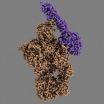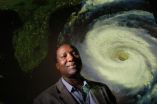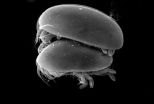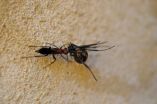(Press-News.org)
VIDEO:
The animation shows how the MASP-2 (blue) attaches itself to the complement protein C4 (orange), and the structural rearrangements that occur in the C4 due to this. Note that although...
Click here for more information.
The complement system is part of the innate immune system and is composed of about 40 different proteins that work together to defend the body against disease-causing microorganisms. The complement system perceives danger signals in the body by recognising characteristic molecular patterns presented by pathogenic microorganisms or some of our own sick or dying cells that must be eliminated.
The complement system can be found in the blood, but also in the fluid surrounding the cells in tissues. Complement serves as the first line of defence against many pathogenic organisms, and its recognition of danger signals is handled by specialised proteins in the complement system.
For more than 20 years, Professor Steffen Thiel at the Department of Biomedicine, Aarhus University, has been a world leader in studies of MBL and MASP-2, which are two key proteins in the complement system. When MBL recognises the danger signal, MASP-2 is converted into an active enzyme that can now cleave the protein C4, a third important protein in the complement system. This cleavage is the first step in a chain reaction that ends with the elimination of pathogenic bacteria and dying cells. A research team led by Associate Professor Gregers R. Andersen at the Department of Molecular Biology and Genetics, Aarhus University, has now – in collaboration with Professor Thiel – succeeded in determining in atomic detail how the active enzyme MASP-2 recognises the substrate C4.
Crystals shot with X-rays
Two PhD students in molecular biology, Rune T. Kidmose and Nick S. Laursen, isolated the protein C4 from blood plasma, whereas they obtained the MASP-2 from Hungarian colleagues. They then crystallised the substrate C4 alone, but – to their surprise – they could also crystallise the enzyme-substrate complex C4·MASP-2. By exposing the resulting crystals to intense X-ray radiation, the two students managed within a year to determine the atomic structures of the C4 protein and the C4·MASP-2 complex. Two other PhD students, Sofia Sirotkina and Troels R. Kjaer, then performed laboratory experiments showing that the conclusions based on crystal structures were also valid when MASP-2 cleaved C4 in a test tube.
Potential impact on drug development
The results obtained by Rune T. Kidmose and Nick S. Laursen are remarkable. "It's extremely rare that you can trap a proteolytic (protein-degrading) enzyme in the middle of the process of cleaving an intact protein," says Associate Professor Gregers Rom Andersen, the students' supervisor. "We now know in detail which parts of MASP-2 recognise the substrate C4. Another fascinating aspect of their results is that we also know the structure of both C4 and MASP-2 alone, so we can see how both the enzyme and the substrate change their three-dimensional structure when C4 is recognised by MASP-2. We can also see how these changes directly contribute to facilitating the cleavage of C4," he concludes.
For Professor Thiel, the new results represent a completely new way to visualise how MASP-2 – whose function he discovered in 1997 – carries out its function. "It's also a great personal pleasure to be involved right from the discovery of a new protein to the point where you obtain knowledge at the atomic level on how this protein functions as an enzyme," he says.
In many situations, an undesirable activation of the complement system takes place, which can damage our own tissues. Several pharmaceutical companies are currently working on developing drugs that can attenuate such damage. "The very detailed understanding that we now have concerning parts of the complement system will undoubtedly lead to more intelligent ways of developing new drugs," says Professor Thiel. "Of course, we won't stop our studies here, as we'll continue the very detailed studies of other proteins and molecular mechanisms within the immune system," he continues.
INFORMATION:
The new results from Aarhus University have just been published in the prestigious journal Proceedings of the National Academy of Sciences (PNAS) entitled: Structural basis for activation of the complement system by component C4 cleavage: http://www.pnas.org/content/early/2012/08/30/1208031109.full.pdf+html?sid=f959b72d-61e6-4e3a-b07f-9a4fe85a159d
Chain reaction in the human immune system trapped in crystals
2012-09-11
ELSE PRESS RELEASES FROM THIS DATE:
More traffic deaths in wake of 9/11
2012-09-11
This press release is available in German.
In the wake of the terrorist attacks of September 11, 2001, many Americans started driving more due to a fear of flying – and lost their lives in traffic accidents. But why did this happen more frequently in some states than in others? And why didn't Spanish driving habits change in the same way following the 2004 train bombings in Madrid? Wolfgang Gaissmaier and Gerd Gigerenzer from the Harding Center for Risk Literacy at the Max Planck Institute for Human Development in Berlin present new findings on this topic in the ...
Lights off? International experts call attention to dangers of exposure to light at night
2012-09-11
"The most important thing for us is to raise awareness of the dangers of artificial light at night and we have already come a long way now that the American Medical Association (AMA) recently announced its new policy recognizing adverse health effects of exposure to light at night and encouraging further research into the matter," said Prof. Abraham Haim, a leading authority on light pollution, who coordinated the 21st International Congress of Zoology (ICZ) that was held last week at the University of Haifa, Israel.
The panel of world experts discussed "Light Pollution ...
Researchers devise more accurate method for predicting hurricane activity
2012-09-11
Researchers from North Carolina State University have developed a new method for forecasting seasonal hurricane activity that is 15 percent more accurate than previous techniques.
"This approach should give policymakers more reliable information than current state-of-the-art methods," says Dr. Nagiza Samatova, an associate professor of computer science at NC State and co-author of a paper describing the work. "This will hopefully give them more confidence in planning for the hurricane season."
Conventional models used to predict seasonal hurricane activity rely on classical ...
A minute crustacean invades the red swamp crayfish
2012-09-11
The small ostracod Ankylocythere sinuosa measures no more than half a millimetre in length and lives on other crayfish. And, Spanish scientists have discovered it for the first time in Europe. The finding suggests that it arrived along with the invader crayfish Procambarus clarkii some 30 years ago but it is still unknown whether it can invade other crustacean species or whether it benefits or damages the expansion of the already established red swamp crayfish.
The red swamp crayfish (Procambarus clarkii) originates from the USA and Mexico and has been present in the Iberian ...
Dartmouth research imparts momentum to mobile health
2012-09-11
Electronic Jewelry for Health
Bracelets and amulets are in the works at Dartmouth's Institute for Security, Technology, and Society (ISTS). Rather than items of mere adornment, the scientists and engineers are constructing personal mobile health (mHealth) devices—highly functional jewelry, as it were.
mHealth is a rapidly growing field where technology helps you or your physician monitor your health through mobile devices. This approach can offer more accurate and timely diagnoses as well as lower health costs. However, smartphones are often used to transmit collected ...
Aussie wasp on the hunt for redback spiders
2012-09-11
University of Adelaide researchers say a small wasp that scientists had forgotten about for more than 200 years is now making a name for itself – as a predator of Australia's most common dangerous spider, the redback.
The wasp (Agenioideus nigricornis) was first described scientifically in 1775 by Danish entomologist Johan Christian Fabricius, thanks to samples collected in Australia during Captain Cook's first great voyage (1768).
"Since then, scientists have largely forgotten about the wasp," says Professor Andy Austin from the University of Adelaide's Australian ...
Diet could combat adverse side-effects of quinine
2012-09-11
Scientists at The University of Nottingham say adverse side-effects caused by the anti-parasitic drug quinine in the treatment of malaria could be controlled by what we eat.
The research, carried out by Nottingham scientists on the University's campuses in the UK and Malaysia, indicates that natural variation in our levels of the amino acid, tryptophan, has a marked bearing on how we respond to quinine treatment. It appears that the lower our levels of tryptophan the more likely it is that we would suffer side-effects. And because tryptophan is an essential amino acid ...
A study analyzes the search for information in stock photography agencies
2012-09-11
VIDEO:
Research carried out at Universidad Carlos III in Madrid analyzes the search and visualization systems used by commercial stock photography agencies, whose estimated annual net sales reach over 150 billion...
Click here for more information.
Stock photography agencies, and not just those companies that dominate the digital photography market, are at the forefront of information search tools. "Their search, visualization and information downloading systems are extraordinarily ...
Vitamin C and beta-carotene might protect against dementia
2012-09-11
Forgetfulness, lack of orientation, cognitive decline… about 700, 000 Germans suffer from Alzheimer's disease (AD). Now researchers from the University of Ulm, among them the Epidemiologist Professor Gabriele Nagel and the Neurologist Professor Christine von Arnim, have discovered that the serum-concentration of the antioxidants vitamin C and beta-carotene are significantly lower in patients with mild dementia than in control persons. It might thus be possible to influence the pathogenesis of AD by a person's diet or dietary antioxidants. 74 AD-patients and 158 healthy ...
Risk-glorifying video games may lead teens to drive recklessly, new research shows
2012-09-11
WASHINGTON -- Teens who play mature-rated, risk-glorifying video games may be more likely than those who don't to become reckless drivers who experience increases in automobile accidents, police stops and willingness to drink and drive, according to new research published by the American Psychological Association.
"Most parents would probably be disturbed to learn that we observed that this type of game play was more strongly associated with teen drivers being pulled over by the police than their parenting practices," said study lead author Jay G. Hull, PhD, of Dartmouth ...





